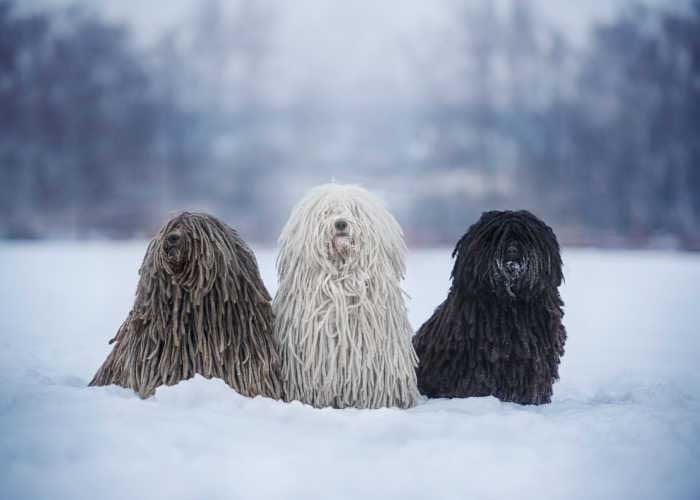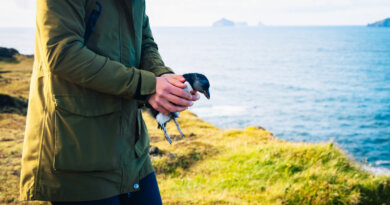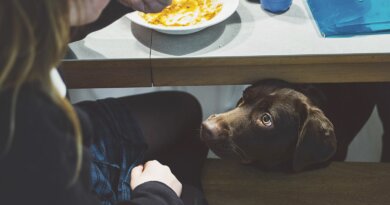Puli Dog Breed Profile – Top Dog Tips
Have you ever seen a dog in dreadlocks? No? Well, we’re here to introduce you to the Puli dog breed.
Puli is known for its long, corded coat that looks like dreadlocks. These mop-like dogs are hardworking herding dogs. But in this day and age, they also make excellent family companions.
The Puli (pronounced poo-lee) is a medium-sized dog that is active, smart, and confident.
These dogs are best at working sheep. They are built for endurance, making them efficient herders all over Hungary for centuries.
You can’t miss the Puli’s distinct coat. Puli’s corded coat can grow so long that it eventually reaches the ground.
If you’re looking to adopt a Puli puppy, this blog can be your ultimate guide about the breed. Today, we’ll discuss everything you need to learn about the breed.
We’ll tackle their grooming needs, physical characteristics, behaviors, and more.
But first, let’s discuss where did this dog breed come from? Scroll down, and let’s start with Puli’s history and origin.
Puli Dog Breed History
The Puli (plural pulik) is an ancient dog breed in Hungary with a history of reaching at least 2,000 years. Their name “Puli” means “drover” and destroyer.”
Moreover, many people believe that the Puli breed is a descendant of the Tibetan Terrier.
When the Magyar tribesman went to Hungary 1,100 years ago, Pulik tagged along with them.
Black Pulik were more prevalent during these times as shepherds preferred black dogs as they were easier to spot among the flock of sheep.
Back then, Puli cost as much as a shepherd’s full year of income.
During the 1800s, these shepherds were committed to breeding Pulik with the best characteristic. And by the late 1800s, the first description of the breed was written.
However, this was also the same era when the need for sheepdogs was diminishing.
Pulik worked closely with the Komondor. But the Komondor’s task was to guard livestock against predators and thieves at night. Komondors are a close-cousin breed of the Pulik.
In this day and age, the Puli dog is thicker, and it has a heavier coat than its working ancestors. Their coat’s maintenance will be much harder than for a working Puli.
Puli Physical Characteristics
Now, let’s take a look at Puli’s physical appearance. The Puli is a unique breed with a remarkable appearance due to its special coat.
They are a hardy and agile breed originally bred for herding and are still used today.
Usually, male and female Pulik are typically similar in size, with males being slightly larger on average.
The average height for a male Puli is between 16 to 18 inches at the shoulder. On the other hand, females normally stand between 14 to 16 inches.
Furthermore, the average weight for a male Puli is between 25 to 35 pounds, while females usually weigh between 20 to 30 pounds (9-14 kg).
The Puli has a very unique coat that is unlike any other breed. Their coat is dense and corded. Meaning it forms long, cylindrical cords that look like dreadlocks.
These cords will develop around 8-12 months old and will continue to grow and form throughout their lives.
It can grow up to 10 inches long and is formed by the dog’s hair tangling and matting together.
The Puli’s coat can be black, white, or gray, but the most common color is black.
The cords help protect the Puli from harsh weather and serve as camouflage when herding sheep.
However, if you plan to adopt a Puli dog, remember that their coat requires regular maintenance to keep the cords from becoming too heavy and prevent matting.
The Puli’s body is compact and muscular, with a deep chest and strong legs. On the other hand, their tail is typically docked to about one-third of its original length.
Moreover, their head is wedge-shaped and proportional to the body. Their eyes are round and dark and are set deep in the skull. The Puli’s ears are V-shaped and hang down.
Puli Temperament
The Puli dog breed is known for being energetic, intelligent, and loyal. They are also popular for being independent thinkers.
However, with their intelligence, they can sometimes be stubborn or headstrong, which can make training a bit of a challenge.
If you’re looking for a watchdog, Pulik are very protective of their families and can be wary of strangers.
However, early socialization is key to preventing them from becoming overly aggressive or anxious around unfamiliar people or other pets.
Pulik have high energy levels and a need for exercise. They do best in homes with large yards to run around and play.
They are best suited for owners who can provide them with plenty of opportunities for outdoor activity.
Overall, the Puli dog breed makes great companions for those willing to put in the time and effort to train and socialize them properly.
Living with a Puli
With proper socialization and training, Pulil can do well with children and other pets, especially if they grew up together.
They are loyal and protective of their families, making them great companions for children.
However, remember that they are herding dogs, and their herding instinct can cause them to try to herd children or other pets.
As pet owners, we must supervise interactions between both parties.
And if you have other pets in your home, Pulik can be cautious around unfamiliar animals and may try to assert their dominance, especially with other dogs of the same sex.
But correct socialization and training can help prevent any issues from arising. Introduce new pets slowly and carefully and monitor their interactions closely.
Puli Dog Training
The Puli is an intelligent and trainable breed, but they can also be independent and stubborn sometimes.
As discussed earlier, early socialization and obedience training are essential for this breed to develop good manners and become well-adjusted family members.
Positive reinforcement training methods work best with Pulis. They respond well to praise, treats, and other rewards for good behavior.
Harsh training methods or physical punishment are never advised, as they can be counterproductive and damage your bond.
Exercise
Pulik are full of energy as they are very active. But this means this dog breed requires regular exercise to keep them physically and mentally healthy and happy.
Pulik loves activities that challenge their mind and body.
If you plan to adopt a Puli, its daily exercise routine should consist of at least one or two brisk walks, runs, or jogs, each lasting 30 to 45 minutes.
Also, Pulik enjoy playing games such as fetch, frisbee, or agility exercises.
Moreover, these dogs also require mental stimulation, such as obedience training or playing interactive games that challenge their intelligence.
The lack of exercise and mental stimulation causes boredom. And it can lead to them developing destructive behavior such as excessive barking, digging, or chewing.
You wouldn’t want to return to your house in a wreck, right? It’s important to provide them with an outlet for their energy so they remain healthy and happy.
Health Care of a Puli
Generally, the Puli is a healthy breed. The Puli breed can live up to 12 to 16 years of age.
However, just like any other dog breed, they are prone to some health issues you should be aware of.
Adopting a Puli from a reputable breeder who can provide health clearances to the parents and the puppies is best advised.
Regular veterinary check-ups, a healthy diet, and regular exercise can also help to keep the Puli healthy and happy.
Below, we’ve gathered a few health problems that Puli dogs are prone to.
Hip Dysplasia
Hip Dysplasia is a genetic condition wherein the socket of the joint and ball becomes distorted.
If your dog gets diagnosed with hip dysplasia, it’s important to keep their weight within the standard range and have them exercise with activities that encourage joint therapy.
Your vet can prescribe medications for anti-inflammatory, pain relievers, and supplements for this condition.
For prevention, keep them active and ensure they are getting enough exercise but not to the point that they might injure themselves.
Progressive Retinal Atrophy
Progressive Retinal Atrophy, or PRA, is another health condition the Puli is prone to.
This condition affects the rod and cone cells in the eyes, leading to blindness. Unfortunately, this disease can progress quickly from a year or two.
It is also a hereditary disease known to have no treatment yet. Having your dog’s eyes frequently checked is best advised to reduce the risk of PRA.
Cataracts
A cataract is an obstruction of lens fiber in the lens of an eye. The gradual clouding of the lens in the eyes.
Although this is more common in elderly dogs, it can also be acquired through genetics, traumatic eye injuries, nutritional deficiencies, or diabetes.
Have your pet undergo an ophthalmic examination to detect small cataracts as early as four to five.
To determine whether it is blinding, it is better to check with your veterinarian to be informed what procedure should be done.
Grooming
The Puli dog breed is known for its unique corded coat. However, with a great coat comes great responsibilities.
It requires regular grooming to keep it healthy and looking its best.
The Puli’s “dreadlock” coat should be brushed daily to prevent the cords’ matting and tangling.
You can use a slicker brush or metal comb to separate the cords and remove any dirt or debris gently. Make sure to brush down to the skin to avoid matting.
On the other hand, Pulik do not need frequent baths. But when they do, use a mild shampoo and thoroughly rinse out all the soap.
Drying the coat completely after bathing is important, as a wet coat can lead to matting.
Keep their nails short by trimming them regularly. When trimming their nails, a good rule is never to let them touch the ground.
A lot of Pulik require the help of a professional groomer to keep their coat in peak condition.
If you’re unsure how to groom your pet, a professional groomer can help trim, bathe, and groom the coat to keep it healthy and looking its best.
Frequently Asked Questions About the Puli
Is the Puli a good family dog?
Yes, the Puli can make a great family dog. They are affectionate with their family members, good with children, and protective of their home.
They require socialization and training from a young age to become well-adjusted and obedient family members.
How rare is a Puli?
In this day and age, the Puli is still considered a relatively rare breed. Only about 150 Pulik registered yearly, compared to 60,000 golden retriever puppies.
While they are recognized by many kennel clubs, including the American Kennel Club and the United Kennel Club, they are not as commonly seen as some other breeds.
What do Puli dogs eat?
Like any other dog breed, the Puli requires a balanced and nutritious diet to maintain good health.
However, the amounts and type of food they need will depend on their age, weight, and activity level.
For instance, Puli puppies and adult Pulik have different nutritional needs, so choose a food appropriate for your dog’s age.
Also, be aware of the portion size. Overfeeding can lead to obesity and other health problems.
Puli Dog Breed Profile Summary
The Puli is an ancient Hungarian herding breed with a unique and distinctive breed known for its corded coat and energetic personality.
These dogs have a long history of working alongside shepherds to help manage flocks of sheep.
Today, they are primarily kept as companion dogs, but their herding instincts and high energy make them well-suited for agility and obedience training.
The Puli is an intelligent and loyal breed that requires daily exercise and mental stimulation to stay healthy and happy.
They can be reserved with strangers but are affectionate and protective of their family members.
While their unique coat requires regular grooming, the Puli’s special appearance and loving nature make them a beloved breed among dog enthusiasts.
READ NEXT: BRIARD DOG BREED PROFILE









